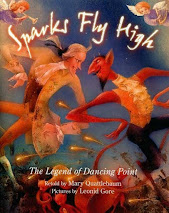My favorite is her book for this list on fairy tales: Sparks Fly High: The Legend of Dancing Point, retold by Mary Quattlebaum, pictures by Leonid Gore.
The story is a "deal with the devil" book. It is based on a classic trope that receives its own number in the Stith Thompson's Motif-Index of Folk-Literature.
The trope is the deal itself. It includes an entire range of motifs, such as crossroads, as well as a variety of solutions. American lore, generally, favors giving the human the win. One of the first Davenport films I reviewed, Bearskin, involves a deal with the devil and a subsequent win, especially considering that Bearskin forces the devil to wash him. "The Devil and Daniel Webster" involves a win--by the lawyer!
The most famous American deal with a devil--other than the constant deals in Supernatural--is, for me, "The Devil Went Down to Georgia" (see below).
 |
| St. Christopher is now considered |
| legendary--but not fantastical! |
The selections in this post raise a point that I have partly addressed in this list but not fully: where do legends fall? Religious tales, I argue, are different from fairy tales, in part because they contain no magic and are specific to a time, place, and "real" person. Even Catholic Saints who are now considered non-historical, still are placed in a historical setting and treated as potentially real. And miracles are considered part of God's natural order.
But, then, many supernatural beings are often considered part of the world's everyday workings. In 1895, Bridget Cleary was killed for supposedly being a changeling. In 1892, Mercy Brown was dug up as part of the New England Vampire Panic. The events are documented--they don't even fall into the category of legend.
So what about devils? "The Devil and Daniel Webster" by Stephen Vincent Benet evokes a real human person, after all.
I would place Bearskin into fairy tales, "The Devil and Daniel Webster" into legend, Sparks Fly High into the middle territory. The first is MEANT to be a fairy tale and does contain magical events beyond the devil, including the fantastical appearance of coins. The second is a morality tale, being commentary on American politics more than anything else. Sparks Fly High is a "how did that come about?" tale, placing it in the same category as Aesop.
Of course, many of these stories and others find their way into 398.2! It's the safety net for everything that might, possibly, be true--but doesn't have to be.




No comments:
Post a Comment